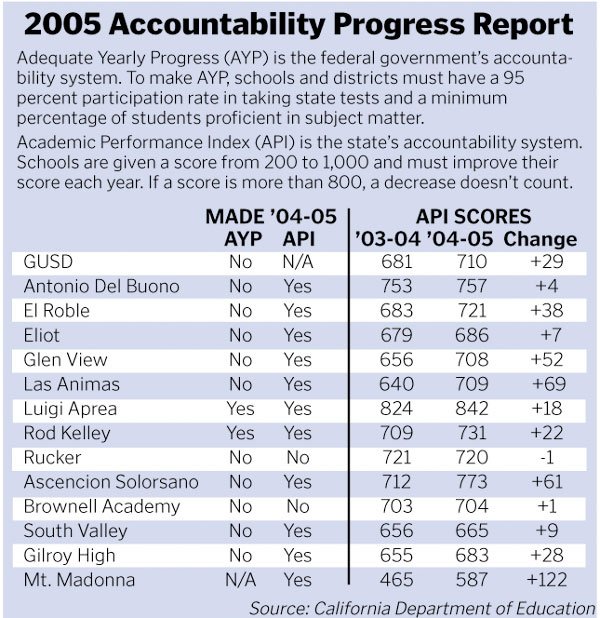Gilroy
– Local school officials are frustrated over the discrepancy
between two accountability systems that measure student
performance.
Gilroy – Local school officials are frustrated over the discrepancy between two accountability systems that measure student performance. Despite 10 Gilroy schools meeting state performance goals, only two met federal standards, according to information released by the California Department of Education Wednesday.
While 81 percent of California’s public schools reached their state growth targets – an increase of 17 points over last year – only 56 percent met their federal targets, a decrease of nine points.
And it is this dichotomy that has district officials struggling to determine what it all means.
“It’s very frustrating when you have different accountability systems when under one, you are doing extremely well, and on the other, you are in danger of (federal) program improvement – it sends mixed messages,” said Gilroy Unified School District Superintendent Edwin Diaz.
Under the federal No Child Left Behind Act of 2001, all students are expected to be 100 percent proficient in both math and language arts by 2014. The federal accountability model uses Adequate Yearly Progress (AYP) to measure a school’s proficiency and is based on criteria set under the NCLB Act. Schools can be sanctioned after not meeting AYP standards two years consecutively. A list of sanctioned schools will be available next month.
The state uses another system called the Academic Performance Index to determine progress, which calculates a school’s growth from one year to the next.
Both models use results from the Standardized Testing and Reporting Program and California High School Exit Exam, however, AYP sets a benchmark for success whereas API uses growth.
“To me, the API is a much more accurate indicator because it is based on growth, not some arbitrary status bar,” said State Superintendent of Public Instruction Jack O’Connell. “Focus on the growth … The starting line is not the same for all students.”
To meet federal 2005 criteria, the minimum percentage of students proficient in English Language Arts must be 24.4 percent for elementary and middle schools and 22.3 percent for high school. For math, at least 26.5 percent must be proficient at the elementary and middle school level and 20.9 percent at high school. All subgroups must meet these marks.
This year, the standards under NCLB doubled, making it more difficult for subgroups such as English Language Learners and students with disabilities to reach the bar. The state failed to meet both its requirements for ELL and students with disabilities.
According to Diaz, based on the California Standard’s Tests, had just 28 more ELL students scored in the proficient range, schools would have met their AYP targets.
“Twenty-eight kids in the whole district – that’s not much,” he said.
API scores are based on a scale of 200 to 1,000 with a state set goal of 800. To meet state API targets, a school must score either 800 or above, or meet a figure at least 5 percent of the growth needed to reach a score of 800.
Under the AYP system, it is possible to lose API points and still meet federal standards. However, despite increasing API scores, a school is not guaranteed to meet requirements under NCLB.
For example, Las Animas Elementary School was just one of several schools throughout GUSD that achieved double digit growth, but still failed to make its AYP goal. In one year, it jumped 69 API points.
Ascension Solorsano Middle School scored 61 API points over last year and still failed to make federal standards because three subgroups did not make the cut.
“We saw some very significant growth, but we didn’t meet that math target,” said Solorsano Principal Sal Tomasello.
Although the school did increase its ELL proficiency in English Language Arts about 11 percent, it failed to make the 24.4 percent benchmark.
“(The discrepancy) will be very difficult to explain to parents because you have to separate state accountability standards from federal accountability standards,” Tomasello said. “Be proud of the fact that we showed growth.”
He contributes their growth to the district’s usage of data team analysis, where teachers use data to determine the areas in the curriculum they need to focus on, and its write-across-the-curriculum program.
“One of the things that we really focused on was our goal of setting individual students results. … Where do they need to be to be proficient in the eyes of the state?” Tomasello said.
To help improve student performance, more than 300 students are taking double math courses this year and a full time teacher will work with migrant students at Solorsano, he said.
Since 1999, all schools throughout GUSD have experienced growth, moving the number of schools closer to the 800 barrier. Eight schools broke the tape scoring above 700 API points this year – a new high for GUSD.
“I think you see so much more consistency now in the district,” said Assistant Superintendent of Educational Services Jackie Horejs.
In 1999, there was an API high of 830 at Luigi Aprea and low of 476 at Las Animas – a difference of 354 points. This year, there was a high of 842 at Luigi Aprea and low of 665 at South Valley Middle School – a difference of 177 API points.
“As far as the gap among schools, that’s closing,” Horejs explained.
However, one standout API performance was by Mount Madonna Continuation High School, which gained more than 120 points this year.
New Mt. Madonna Principal Sergio Montenegro went into every classroom to share the news.
“They were beaming,” he said. “I know that in regards to growth it’s pretty much unheard of.”
Montenegro is also serving as principal of Luigi Aprea Elementary School – the only school in GUSD that has consistently met the 800 mark every year since 1999.
This year, Luigi Aprea grew another 18 points to 842 and is one of two in GUSD that also met its AYP target.
“Eighteen points at our level in the mid-800s is quite a feat,” Montenegro said, attributing the success to his staff’s collaboration and data team analysis increase student performance.
While Gilroy High School failed to meet the 800 marker, it experienced a 28 point API growth to 683 – easily reaching its state goal. GHS is one of 83 percent of high schools that met their API target, and one of 31 percent that missed the AYP requirement.
“The whole system is so complicated,” said new GHS Principal James Maxwell.
While he believes the API is an accurate performance measure, he is uncertain if it is the best.
“It’s something we know, something we can analyze and something we can work towards,” he said. “It measures standards.”
While O’Connell is working to change federal requirements so that API scores are used in replace of AYP in the state of California, Maxwell is determined to achieve the standard using either figure.
“I just want to know what the number is and I’ll get there,” he said. “I’m not afraid of (the NCLB standards.) … You set goals and you try to achieve them.”















